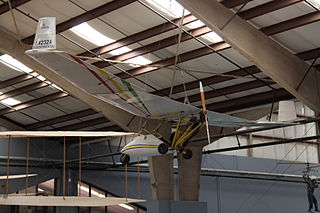Related Research Articles

The Advanced Aeromarine Sierra was an American high-wing, strut-braced, single-seat, glider that was designed and produced by Advanced Aeromarine, as a kit for amateur construction.

The Schweizer SGS 1-23 is a United States Open and Standard Class, single-seat, mid-wing glider built by Schweizer Aircraft of Elmira, New York.

The Windward Performance SparrowHawk is an American mid-wing, single-seat glider that was designed and produced by Windward Performance. It first flew in 2002.

The Slingsby T.21 is an open-cockpit, side-by-side two-seat glider, built by Slingsby Sailplanes Ltd and first flown in 1944. It was widely used by the Royal Air Force, Sri Lanka Air Force and by civilian gliding clubs.

The PIK-5 was a training glider produced in Finland in the 1940s, and 1950s, equipping the country's gliding clubs with an aircraft greater in performance than primary gliders but less than competition sailplanes.

The Slingsby T.12 Gull was a British single-seat glider designed and built by Slingsby Sailplanes and first flown in 1938.

The Slingsby T.30 Prefect is a 1948 British modernisation of the 1932 single-seat Grunau Baby glider. About 53 were built for civil and military training purposes.

The Marske Monarch is a single-seat, high-wing, strut-braced, tailless ultralight glider and motor glider that was offered both as plans and a kit for amateur construction by Marske Aircraft.

The Johnson RHJ-6 Adastra was an American mid-wing, two-seat glider that was designed and constructed by Dick Johnson and first flown on 3 April 1960.
The Czerwiński Sparrow, sometimes known as the de Havilland Canada glider, was a single seat glider, designed and built by a group of de Haviiland engineers in Canada in 1942. It was intended to popularise gliding and be suitable for both basic training and thermal soaring.

The Hütter Hü 17, is a German high-wing, strut-braced, single-seat, utility training glider that was designed by brothers Ulrich Hütter and Wolfgang Hütter in the 1930s.

The Schleicher Ka-4 Rhönlerche II, sometimes called the KA-4 or even K 4, is a West German high-wing, strut-braced, two-seat glider that was designed by Rudolf Kaiser and produced by Alexander Schleicher GmbH & Co.
The Reinhard Cumulus is a West German high-wing, strut-braced single-seat, glider that was designed by Gerhard Reinhard for amateur construction.
The Bailey-Moyes Tempest, is an Australian-American high-wing, strut-braced, single-seat, microlift glider that was designed by Bob Bailey of Florida, United States and produced by Moyes Microlights of Waverley, New South Wales, Australia.

The Volmer VJ-24W SunFun is an American high-wing, strut-braced, single-seat, pod-and-boom motor glider and ultralight aircraft that was designed by Volmer Jensen and provided as plans for amateur construction by his company Volmer Aircraft of Glendale, California.

The Sandlin Bug is an American biplane, cable-braced, single-seat, ultralight glider that was designed by Mike Sandlin and is provided in the form of technical drawings for amateur construction.

The Sandlin Goat is an American parasol wing, single-seat, ultralight glider that was designed by Mike Sandlin and is provided in the form of technical drawings for amateur construction.

The Technoflug Piccolo is a German high-wing, T-tailed, single-seat motor glider that was designed and produced by Technoflug of Schramberg. It first flew in 1980.

The Mitchell Wing B-10 is an American high-wing, open cockpit, single-seat, tailless, ultralight aircraft and motor glider designed by Don Mitchell and based on his Mitchell Wing hang-glider. It has been produced by a variety of companies in the form of kits and plans for amateur construction. It first flew in 1980.

The Scheibe Specht is a tandem seat training glider produced in Germany in the early 1950s. More than fifty were built.
References
- 1 2 3 4 Activate Media (2006). "Super Floater US Aviation" . Retrieved August 29, 2011.
- 1 2 3 4 5 Johnson, Dan (March 1995). "Product Lines March 1995". Hang Gliding Magazine. Retrieved August 29, 2011.
- ↑ Federal Aviation Administration (August 2011). "Make / Model Inquiry Results" . Retrieved August 29, 2011.
- ↑ Downey, Julia: 1999 Kit Aircraft Directory, Kitplanes, Volume 15, Number 12, December 1998, page 74. Primedia Publications. ISSN 0891-1851
- 1 2 Purdy, Don: AeroCrafter - Homebuilt Aircraft Sourcebook, page 314. BAI Communications. ISBN 0-9636409-4-1
- ↑ Bertrand, Noel; Rene Coulon; et al: World Directory of Leisure Aviation 2003-04, page 59. Pagefast Ltd, Lancaster OK, 2003. ISSN 1368-485X
- ↑ "J2mcL Planeurs - Fiche planeur n°". www.j2mcl-planeurs.net. Retrieved May 21, 2022.